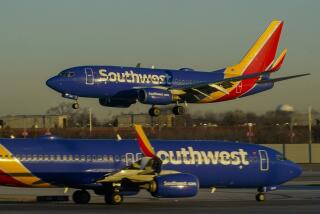Think airline seating is tight now?
- Share via
If you think airline passengers are already feeling cramped, check out the SkyRider, a seat that resembles a padded saddle and lets airlines squeeze in up to 40% more travelers per flight.
The seat has not been approved by the Federal Aviation Administration or purchased by any major airline, but it drew crowds when it debuted this week at the Aircraft Interiors Expo at the Long Beach Convention Center.
With the U.S. airline industry still staggering from $58 billion in losses since the terrorist attacks of 2001, the new saddle seat represents the latest idea for wringing as much revenue as possible out of each flight.
Other money-saving ideas on display at the expo included an in-seat entertainment system with a built-in credit card reader, passenger seats and overhead bins made of lighter material to reduce fuel costs, and carpeting and seat covers that need less maintenance.
“We would like to help an industry that is not making a profit,” said Fredrik Meloni, a sales manager for Italy-based Aviointeriors, the designers and manufacturers of the SkyRider seat.
Still, airline analysts predict such extreme measures as the saddle seat may be limited to a few economy air carriers such as Ireland’s Ryanair or Florida-based Spirit Airlines.
“I don’t think that most airlines ... would even consider them, so consumers will still have some choices when it comes to comfort,” said Anne Banas, executive editor at SmarterTravel, an online consumer travel website.
A spokeswoman for Spirit Airlines said the company had yet to see the SkyRider seat and could not comment on it. Ryanair could not be reached for comment.
The airline industry had nearly recovered from the Sept. 11 terrorist attacks when the recession hit in 2007, dramatically cutting demand, particularly among business travelers who began flying less, booking economy-class seats and staying in cheaper hotels.
Although demand for airline seats and prices has begun to inch up in the last few months, the industry is still staggering, with airline executives worried that a jump in fuel prices could send the industry into another nose dive.
At the Long Beach expo many exhibitors unveiled lightweight airline cabin fixtures -- seats, overhead bins and other interior modules -- aimed at cutting fuel costs, air carriers’ second-highest expense behind labor.
“Airlines, in general, are now looking for more efficient ways to do business,” said Beth Blake, a spokeswoman for Reed Exhibitions, the company that organized the exposition.
For example, Lumexis, an Irvine technology company, introduced an in-flight entertainment system that uses fiber optics and weighs about 822 pounds per plane, about half the weight of a typical entertainment system.
“The two main qualities airlines are looking for are reliability and weight savings,” said Malcolm Tipple, regional sales director for Lumexis.
Relaxor, a Santa Fe Springs company that manufactures airline seats with built-in massage systems, introduced a new massage motor that weighs about half as much as older motors, paring the weight of the system to about 2 pounds per seat. The massage seats are already installed in several airlines in the Middle East, Europe and China.
“The response has been phenomenal,” Mark Hodgson, an account executive for Relaxor, said of the lighter motor.
The makers of the SkyRider seat say the seat is much lighter than traditional airline seats and is easy to clean. But the biggest selling point remains how little space it takes up in a cabin.
The seat puts passengers in a semi-standing position, allowing airlines to leave only 23 inches of space between each row of seats, compared with traditional airline seats that are positioned 31 to 35 inches apart. Passengers must tuck their knees into the back of the seat in front. The seats don’t recline, though they do have a small retractable tray.
Meloni, the company representative, suggested that the seats would be used only for short flights, no longer than two hours.
Meloni said several U.S. airlines had expressed interest in the seat but declined to name then until the deals have been signed.
Several industry employees who tried the seat at the exhibition were skeptical that the SkyRider would fly with passengers.
“When I first looked at it, it looked like a roller coaster seat,” said Dean Purcell, a sales manager for Massachusetts-based Draka Cableteq, a cable and wire manufacturer. Exiting a seat can be difficult, he said. “I would hate to be in the middle seat and have to go to the bathroom.”
After Gerard Melling squeezed his 6-foot-2 frame into a seat he said he felt a bit claustrophobic and wondered if anyone could sit in the SkyRider for more than an hour.
“It’s built for people with short legs,” joked Melling, general manager for Mitsui Bussan Aerospace Corp. in Long Beach. “Even an hour in that seat would be tough.”
More to Read
Inside the business of entertainment
The Wide Shot brings you news, analysis and insights on everything from streaming wars to production — and what it all means for the future.
You may occasionally receive promotional content from the Los Angeles Times.











